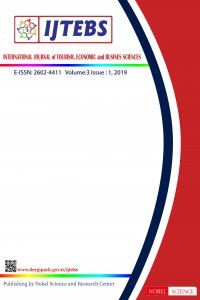AN ANALYSIS OF TOURISM DEVELOPMENT: TOURISM PARADOX, TOURISM EQUINOX AND TOURISM DETOX
AN ANALYSIS OF TOURISM DEVELOPMENT: TOURISM PARADOX, TOURISM EQUINOX AND TOURISM DETOX
Having the tourism industry as the only development model for a country with its natural and culturalresources could not only destroy the social life but also the tourism industry itself. Although the equation “moretourists = more tourism income” is so simple, it is not a sustainable approach for the development plans of thedestinations. New buildings, new lifestyles, new social and commercial relationships will rapidly replace old onesat the destination. The prospects of even more income will cause an increase in the tourism revenue generationcapacity of the destination which often causes deterioration and devastation of the attractions at the destinationand a decrease of the tourism earnings. This process leads to overuse of natural and cultural attractions and placespressures on tourism earnings. ”Tourism paradox” is the name of this concept. Tourism paradox is the name givento this phenomenon where tourism industry destroys natural and cultural environment that is necessary for tourismactivities. The growth of tourism cannot be always considered as having a positive impact for destinations.The balance, which does not change and disturbs the social and economic relations at the destinationis called “tourism equinox”. New projects and approaches to solve the problems caused by the growth of urbanpopulations and establish healthy sustainable tourism destinations are becoming more important than ever.Tourism detox is a treatment that is intended to remove harmful substances from the destination. Detox is a radicaldecision and it is not an easy process. Therefore, spatial reorganization and urban regeneration play a crucial rolefor the marketing of destinations and this transformation action affects all infrastructure facilities, restorations ofold buildings, reorganization of historical zones, and revitalizing the architectural style of the destinations. Thisanalysis investigates the influence of tourism paradox and tourism equinox on destinations in relation to tourismactivities and the protection of natural and cultural resources with the help of tourism detox.
___
- Diekmann, A. & Gillot, L., (2010). Heritage and Tourism: A Dialogue of Deaf? The Case of Brussels. Led Online E-Journals, Rivista di Scienzedel Tourismo Ambiente Cultura Diritto Economia (in English), Vol (3), pp.263-280.
- Kaya, E., (2014). From Industrial and Residential to a Tourism Precinct: The Rocks of Sydney, University of Western Sydney, Australia.
- Kılıç, S.E. & Aydogan, M., (2015). Sustainable Tourism and Heritage in Sigacık/Seferihisar. International Journal of Social, Behavioral, Educational, Economic and Management Engineering, Vol(9), No(1), p.310.
- Lopez, L. & Palomino, B., (2003). Impacts of Mass Tourism on Local Communities and the New Phenomenon of Colonization-Case Study: Majorca. MA Thesis, Bournemouth University, England, p.76.
- Randelli, F., Romei, P., Tortora, M. & Tinacci, M., (2012). Rural Tourism Driving Regional Development in Tuscany. The Renaissance of the Countryside, Department of Economic Sciences, University of Florence.
- Teo, P. & Huang, S., (1995). Tourism and Heritage Conservation in Singapore. Annals of Tourism Research, 22(3), pp.58-615.
- Timothy, D.J., &, Boyd, S.W., (2003). Heritage Tourism, Pearson Education.
- http://www.gdrc.org/uem/eco-tour/envi/one.html. (18.01.2015)
- http://www.karl.aegee.org/oem/articles/oe8/t-freedo.htm/p. (21.02.2015)
- www.exofoundation.org/the-paradox- of-tourism. (29.12.2014)
- Başlangıç: 2017
- Yayıncı: Nobel Bilim ve Araştırma Merkezi Limited
Sayıdaki Diğer Makaleler
Hatice GÜÇLÜ NERGIZ, Banu Saadet ÜNSAL AKBIYIK
KONKORDATO FİNANSAL KRİZDE ÇÖZÜM MÜ?
Süheyla BAYRAKTAR, Tülay POLAT ÜZÜMCÜ
HİZMET ÜRETİM MALİYETİ VE TMS 2 AÇISINDAN KONAKLAMA İŞLETMELERİ MALİYET KAYITLARI
SATIN ALMA DAVRANIŞLARINDA KADINLARIN GİYSİ MARKASI TERCİHLERİNİ ETKİLEYEN FAKTÖRLER
HİBE DESTEKLERİNİN FİRMA İNOVASYONUNA ETKİSİ: TÜRKİYE ÖRNEĞİ
Gökçe MERCAN, Ahmet Kibar ÇETİN
İNOVASYON GÖSTERGESİ OLARAK İNOVASYON ENDEKSLERİ
KONAKLAMA İŞLETMELERINDE KIŞI-ÖRGÜT UYUMU VE DUYGUSAL EMEK DÜZEYLERI ARASINDAKI İLIŞKININ ANALIZI
Haluk TANRIVERDİ, Dilbar GULIYEVA
Hale BÜTÜN BAYRAM, Süheyla BAYRAKTAR
AN ANALYSIS OF TOURISM DEVELOPMENT: TOURISM PARADOX, TOURISM EQUINOX AND TOURISM DETOX
